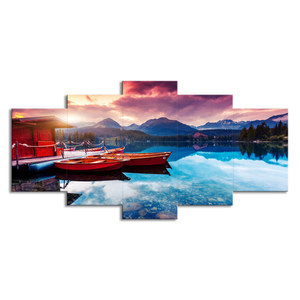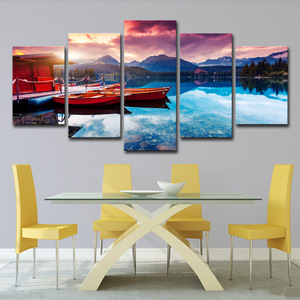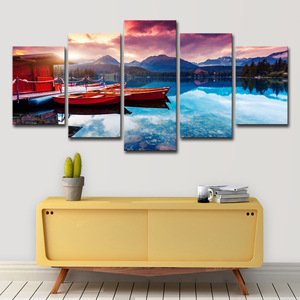(59293 products available)






































































































 Ready to Ship
Ready to Ship

















































































 Ready to Ship
Ready to Ship











Nature paintings are artworks that capture the beauty of the natural world. They include various themes, styles, and techniques, each offering a unique perspective on nature. Below are some common types of nature painting:
Landscape Paintings
Landscape paintings focus on depicting outdoor scenes, including mountains, valleys, trees, rivers, and forests. They can be realistic or impressionistic and capture the beauty of a particular place or the artist's imagination.
Floral Paintings
Floral paintings concentrate on flowers and gardens, showcasing their colors, shapes, and details. These paintings can range from detailed botanical studies to expressive and abstract representations.
Wildlife Paintings
Wildlife paintings portray animals in their natural habitats. They can capture a variety of species and focus on their behavior, interactions, and the beauty of the wilderness.
Marine Paintings
Marine paintings depict the sea, ocean, and coastal landscapes, often including seascapes, ships, beaches, and marine wildlife. They capture the movement, colors, and moods of the water and coastal environments.
Still Life Nature Paintings
Still life nature paintings involve arranging natural objects like fruits, flowers, plants, and rocks to create compositions. Artists capture the details, textures, and colors of the objects in a controlled setting.
Abstract Nature Paintings
Abstract nature paintings take inspiration from natural forms and elements but interpret them in a non-representational way. Artists may use shapes, colors, lines, and textures to convey the essence of nature abstractly.
Environmental and Conceptual Nature Paintings
Environmental and conceptual nature paintings address environmental themes, conservation issues, and human-nature relationships. They may incorporate mixed media, found objects, or conceptual elements to raise awareness about ecological topics.
Designing a nature painting involves careful consideration of composition, color, style, and framing. These elements contribute to a harmonious and visually appealing artwork that effectively conveys the beauty of the natural world.
Composition:
A well-balanced composition is essential for a nature painting. It can be achieved by using the rule of thirds, leading lines, and focal points. Placing the main subject along the gridlines or intersections of the rule of thirds creates visual interest. Leading lines, such as a path or river, guide the viewer's eyes to the focal point. A strong focal point can be obtained by contrasting details or using a different color.
Color:
Colors play a crucial role in conveying the mood and atmosphere of a nature painting. Artists should study the color palette of the natural world and use it to their advantage. Observing how colors complement each other can help create a vibrant and harmonious painting. For example, the warm tones of a sunset are complemented by cool shades of the sky.
Style:
The style of a nature painting can vary from realistic to abstract. The choice of style should reflect the artist's personality and the message they want to convey. A realistic painting requires careful observation and attention to detail, while an abstract painting allows for more creativity and interpretation.
Framing:
A good frame can enhance the presentation of a nature painting. It should complement the artwork without overpowering it. The choice of frame can be influenced by the painting's colors and style. For example, a rustic painting can be presented in a wooden frame, while an abstract artwork may require a sleek, modern frame.
Nature painting can create a calming and peaceful environment in various places. It is beneficial for business buyers who want to decorate their spaces. Here are some ways to use these paintings:
Business buyers can improve their spaces by adding nature paintings. These paintings are not just decorative. They also improve well-being and productivity. Choose art that shows nature scenes to benefit the employees and customers.
Choosing a nature painting can be a rewarding and personal experience. It involves considering the art's aesthetics, emotions, and connection to the natural world. Here are some tips to help make the right choice:
Know the space
Determine the size and style of the space where the painting will be displayed. Is it a living room, office, or gallery? A large painting may suit a spacious area, while a smaller one is better for a compact space.
Consider the style
Decide what kind of nature scenes are appealing. Do they prefer realistic landscapes, abstract nature paintings, or vibrant wildlife depictions? Looking through art websites or visiting galleries can help identify the preferred style.
Think about color
Choose a painting with colors that match or contrast nicely with the space's decor. For example, cool colors like blues and greens can create a calming effect, while warmer colors can add energy.
Look for emotion
Choose a painting that evokes the desired feeling. A serene lake scene might bring peace, while a vibrant flower field could convey joy. Trust the gut feeling when looking at the artwork.
Check the artist
Learn about the artist and their other works. Supporting lesser-known artists can be rewarding, or it may be exciting to own a piece by a more famous painter.
Consider the investment
If the painting is expensive, consider its value and the artist's reputation. Sometimes, buying a print or a nature painting canvas is more affordable and practical.
Trust the instinct
Ultimately, choose a painting that feels right. It should resonate personally and fit the space. Don't be afraid to walk away if it doesn't feel like the perfect match.
Choosing a nature painting is about finding a piece that connects with the viewer. By considering the space, style, colors, emotions, and artist, making a choice can be easier.
Q1: How can nature paintings be preserved and protected over time?
A1: Nature paintings can be preserved by using UV-protective glass or acrylic in their frames and by keeping them away from direct sunlight and extreme humidity.
Q2: Are nature paintings suitable for any interior decor style?
A2: Nature paintings suit almost all interior decor styles, but they especially shine in spaces like offices and living rooms where they can make a big impact.
Q3: What is the significance of nature paintings in today's world?
A3: Nature paintings are significant as they remind people of the natural world, especially in urban settings, and they also raise awareness about environmental issues.
Q4: Can nature paintings be used in commercial spaces?
A4: Yes, nature paintings can be used in commercial spaces to create a welcoming and calming environment for customers and clients.
Q5: What are the current trends in nature painting designs?
A5: Currently, people prefer large-scale nature paintings, those with a minimalist approach, and artworks that show more abstract and whimsical interpretations of nature.